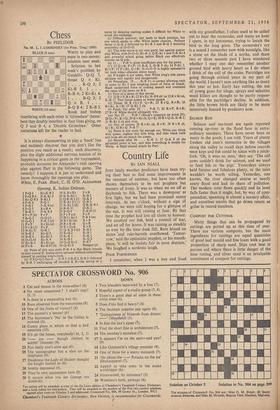Chess
BY PHILIDOR No. 68. L. I. LOSHINSKY (1st Prize, 'Trog,' 1950)
WHITE (10 men)
Solution to last week's problem by G uidel I i Q-Q 7, threat Q x Kt.
It is always disconcerting to play a 'book' line and suddenly discover that you don't like the position you reach as a result; such discovery, plus the slight additional nervous tension of its happening in a critical game in the tournament, probably accounts for Alexander's rash opening play against Parr in the following game. The remedy? 1 suppose it is just to understand and know thoroughly the openings you play.
White, F. PARR Black, C. H. O'D. ALEXANDER Opening, K. Indian Defence.
1 P-Q 4 Kt-KB 3 19 KBxKt PXB
2 P-Q B 4 P-K Kt 3 20 K R-Kt 1 R-B 2
3 Kt-Q B 3 B-Kt 2 21 Q R-B 1 (I) Q-K 4
4 P-K 4 P-Q 3 22 R-Kt 51 ( / ) Q-B 3
5 P-B 3 P-K 4 (a) 23 R-Kt 3 (k) Q R-K H 1
6 P-Q 5 Kt-R 4 24 B-K 31 Q-K 2 7 B-1( 3 P-K B 4 25 B-Q 4 P-B 47 (1) 8 PxP(b) PxP 26 PxPe.p. PxP
913-Q 3 0-0 (c) 27 R(1)-Kt 1 1P"-B 4 (m) 10 Q-Q 2 P-K 5 (d) 28 B x Kt (n) R x B
11 PxP BxKt(e) 29 RxRch QxR 12 PxB(f) PxP 30 RxQch 1Z x R
13 B-Kt 51 Q-K I 31 Q-K B 2 (o) R-B 2
14 B-K 2 Kt-Q 2 32 -Q 2 K-B 1 15 B-R 6 Kt-Kt 2 33 K-K 1 K-K 1 16 0-0-0 Kt-K 4 34 K-B I K-Q 2
17 Kt-R 3 B x Kt (g) 35 0-0 Kt 2 P-B 7 18 P x B Kt-B 6? (h) 36 Q-Kt 8 Resigns (p)
(a) Point of this very early P-K 4 is that Black intends to start typical K. Indian pawn advance without committing himself to castling king's rook. (b) If 8 Q-Q 2 then 8 ... P-B 5; 9 B-B 2, B-B 3; followed by B-R 5 exchanging off blocked K B-the saving of a move by delaying castling makes it difficult for White to avoid this exchange.
(c) Difficult position: text leads to book position, but one which seems to offer White better chances. Perhaps better is Q-K 2 followed by Kt-R 3 and B-Q 2 retaining possibility of 0-0-0.
(d) This wild move is not very good, but against quieter play White, with 0-0-0, Kt-K 2, Q R-Kt 1 and P-K Kt 4 gets powerful attack going before Black can effectively counter on Q side.
(e) 11 . P-B 5; gives insufficient play for the pawn. (f) 12 QxR PxP; 13 B-K 2, Q-R 5 ch; 14 P-Kt 3, Kt x P; 15 P x Kt, QxR; 16 0-0-10 is highly speculative for both sides-chances about equal.
(g) If knight is not taken, then White king's side pawns advance very rapidly and dangerously. (h) Premature. 18 . . R-B 31; is correct allowing rook to come to Kt 3 and breaking much of force of attack. Black underrated force of coming assault and overrated the value of the pawn on B 6.
(1) First of a series of fine moves.
(I) 22 R xP,RxR; 23 BxKt,R-B8chlor23RxKtch, K-12 I 1 Text forces queen to worse square.
(k) Threat 24 R (3)x P, QxR; 25 R x Q, RxR; 26 B x Kt. K x B; 27 Q-Kt 2 ch.
(/) Fatal; but after 25 . . . P-B 7; 26 R X P, RxR; 27 B x R White should ultimately win. (m) Not 27 . . . P-B 7 (Black's intention on move 25); 28QxPl, RxQ; 29 RxKlch,QxR; 30 RXQch,K-R 1; 31 R-Kt 6 ch and wins.
(n) Not, of course, 28 R x Kt ch, R x R; 29 R x R ch, QxR; 30 Bx Q, P-B 7! (o) Pawn is not quite far enough on; White can block with queen. replace this with king, and then black rook and king are no match for queen. (p) Because after 36 . . . K-K 3; 37 Q-K 8 ch the advanced pawn is lost, and then everything is simple for White. A finely played attack by Parr.


































 Previous page
Previous page